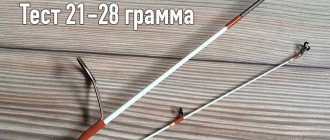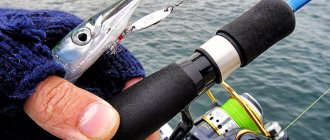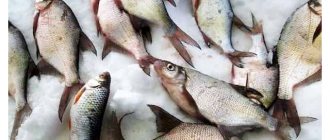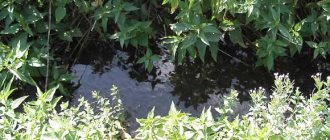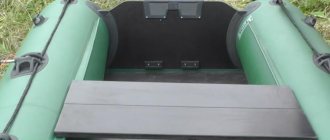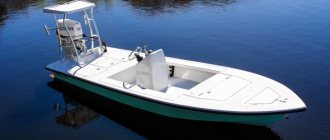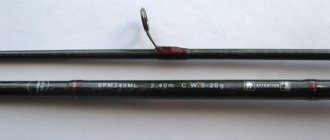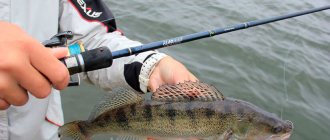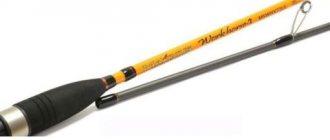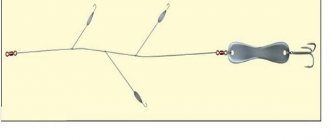Review of spinning rods
February 03
Review of telescopic spinning rods
Telescopic rods – the spinning rod unfolds like a telescope. The design has more connecting joints and nodes, which affects the strength of the fishing rod. Experienced fishermen rarely resort to them, and use them mainly to check the reservoir. The fact is that telescopic spinning rods are not as sensitive to bites (relative to plug-in analogues) and cannot withstand heavy loads when fishing for large fish, but they are very convenient due to their compactness during transportation.
Telescopic spinning rods have been manufactured since the middle of the last century and have undergone a number of changes during this time. Initially, telescopic spinning rods were made of heavy plastic and metal alloys. Such rods were very heavy and did not allow long fishing and long-distance and high-quality casts. After (in 1971), the Japanese company Shimano developed the Aero model range from a complex of carbon fiber and lightweight plastic. Shimano's monopoly lasted until 1986, or more precisely, until the presentation of the Kosadaka telescopic rod series. In 1994, the first series of telescopic fishing rods produced by Daiwa was presented. And until now, these three companies are leaders in this market segment.
In addition to sensitivity, telescopic rods are distinguished by their durability. The fact is that each joint in the rod carries with it an additional risk of breaking the form at the time of fishing. The most common complaint from fishermen about telescopic rods is the fracture of one of the joints at the moment of maximum load. In addition, when the spinning rod is folded, the rings fall on top of each other, which causes their deformation. Every angler has a telescopic rod with reconditioned guides in his arsenal for this very reason.
How to choose a telescopic spinning rod
You need to choose a telescopic spinning rod carefully, given that the market is full of low-quality forms with completely different prices. Thus, Chinese fishing rods with a budget of a thousand rubles can be much better quality than their European “rivals”.
First of all, when choosing a fishing rod, they look at the material used. Carbon rods are the strongest. These forms are lightweight and can withstand loads of up to thirty kilograms. The leaders in the market of carbon telescopic spinning rods at the moment are such companies as: Shimano, Kosadaka, Daiwa.
Rods made from a mixture of fiberglass and fluorocarbon are cheaper, but weigh one and a half to two times more. This causes significant discomfort during prolonged fishing and does not allow you to enjoy catching fish.
Designs and technical characteristics
Length
The length when choosing a fishing rod depends on the preferred bodies of water and the conditions in which fishing will be done.
• Short forms with a length of 1.5 – 2.1 meters are preferred for fishing on small lakes and rivers. • Medium-sized rods (1.9 – 2.7 meters) are the most versatile and suitable for most medium-sized bodies of water. • Long forms (over 3 meters) are used for fishing on large lakes and sea fishing.
Build
The structure of the rod shows the flexibility of the spinning rod, its plasticity and sensitivity.
The following formations are distinguished:
Slow action (S) indicates that the entire form is bent. Slow action rods are the most flexible. A serious drawback of plastic rods is poor sensitivity, for this reason they are not used in Ultralight and microjig. The advantage of a slow action is the ability to cast over long distances.
Fast action (F) means that only the upper part of the spinning rod bends. The rod allows you to feel even the weakest strikes, but does not allow you to make long casts.
Medium tuning (M) or medium-fast tuning has received the most attention and is considered universal. These forms combine the qualities of the first two formations and are suitable for most types of fishing.
Load test
The load (bait) test shows the weight range in which the load will be used. Telescopic spinning rods have practically no options for ultralight and microjig, but there are more than enough medium-sized forms.
The following load tests are available:
1. Ultralight – bait weight up to 7 g. Such rods are used to catch small and very cautious fish. 2. Light – load weight up to 14g. 3. Medium light - medium-light with a load weight of 7 - 20g. Universal models. 4. Medium - medium forms with a weight from 10 to 30g. 5. Hight (heavy) - load weight up to 50 g. 6. The heaviest (extra hight) rods can withstand the weight of bait from 60 g and are designed primarily for fishing in the sea.
Telescopic spinning rod, its structure, differences from plug-in spinning rod
A telescopic spinning rod is a fishing rod that, like an astronomical telescope, consists of retractable parts of varying lengths and thicknesses. The main components of such a spinning rod are:
- Knees are hollow cone-shaped tubes of various diameters that are inserted into each other.
- Passage rings are round metal frames with internal liners made of abrasion-resistant material (cermets, silicon carbide), which have a ring-shaped fastening and are located on the knee at the junction at the very end of the smaller one in diameter. A reinforced small tulip ring is installed on the last bend.
- A reel seat is a device for firmly and securely attaching a reel to a fishing rod. It consists of a support platform, a stop and a fixing element (nut), located in front or behind relative to the butt.
- Handle – in telescopes, the role of a handle can be performed by both the last knee and the handle itself, which is connected to the main part of the rod using a plug-in method. The material of the handle can be different - from cheap microporous rubber, which strongly absorbs moisture and dust, to cork, the distinguishing feature of which is lightness, strength, low thermal conductivity, and a pleasant-to-touch surface.
- Also included with the rod is a protective plastic cap that fits over the guide rings and protects them from damage when carried. At the top of the cap there is a hook with which the folded rod can be hung on a hanger hook fixed in the wall, thus saving space.
The length of a telescopic spinning rod in most cases ranges from 1.8 to 3-3.3 meters.
Test
Like plug-in spinning rods, the test of telescopic spinning rods divides them into 4 main classes based on the weight of the bait:
- ultra-light – suitable for fishing with light baits weighing no more than 7 grams;
- light – the weight of the baits thrown should be from 7 to 15 grams;
- medium – the weight range for rods of this class is from 15 to 30 grams;
- heavy – rods are designed to cast the heaviest baits weighing 30-40 grams or more.
Build
The structure of a telescopic spinning rod is:
- super fast - only the upper part of the tip reacts to load;
- fast - the entire tip bends;
- medium – at least half of the form is subject to bending;
- slow - the whip bends more than half.
Material of manufacture
Telescopic spinning rods are made from materials such as:
- Fiberglass - rods made from this cheap material are rigid, heavy, but at the same time unpretentious and have an affordable price for any angler.
- Composite is a material that is a mixture of cheap and rigid fiberglass and strong and flexible carbon fiber. Fishing rods made of composites are more unpretentious than graphite rods, while being more flexible than fiberglass rods.
- Carbon fiber (carbon) – when carbon fiber is used as a material for the manufacture of telescopic spinning rods, light and durable fishing rods are obtained that are highly flexible and perfectly hook fish. The disadvantage of such spinning rods is their fragility when hitting the edges of hard objects, stones, or falling onto a concrete floor.
Recommended reading: How to catch crayfish using crayfish traps
Criteria for choosing a telescopic spinning rod
Depending on the size of the reservoir and access to casting, the rods are selected as follows:
1) Small bodies of water overgrown with bushes and reeds do not allow the use of long forms. Short forms with a length of up to two meters are best suited here. The same rods are also suitable for catching fish from the side of a vessel. 2) Medium bodies of water allow you to fish with a blank up to 2.4 meters long. Such spinning rods are considered universal and are suitable for most rivers and lakes. 3) Large reservoirs require long casting. In such places, forms with a length greater than three meters are best suited.
Criterias of choice
There is no doubt that when choosing fishing equipment, you should give preference to purchasing with a known quality, and this is guaranteed by a product from a well-known brand, purchased from a reliable retail outlet. The choice of telescopic spinning rod begins with an inspection of the knee joints, the number of which can vary from three to nine elements. Having spread the rod to its full length, check the blank for rigidity by shaking the spinning rod. In a reliable thing, there are no backlashes and inaudible extraneous sounds. The form should not be noodles. If the quality of the tool is normal, the angler will feel the tension of the tackle without any failures in movement.
Important! It is worth paying attention to the accuracy of fitting the rings, which should not move when unfolding, touch each other and bend when folding the gear.
It is preferable to choose a spinning rod with a cork handle and a reel seat made of a light metal alloy, which can at least somehow affect the reduction in weight of the equipment. Having completed the visual inspection and making sure that there are no visible defects, they determine the operating parameters of the spinning rod, selecting the version suitable for the expected fishing conditions. In this direction, the fisherman should highlight the criteria for determining the optimal length of the tackle, the material used to make the rod blank, its structure and test parameters. These values depend on the type of bait used, the type of reservoir being fished and the structure of the coastline, which affects casting, the intensity and methodology of the fishing method. It is on these selection parameters that we will dwell in more detail in the continuation of the article, pointing out to the angler the possible options for choosing.
Material of manufacture
Telescopic spinning rods, like many other fishing equipment, are made from composite plastic materials that differ in the variants of binding components represented by different types of polymers. The most widely used materials for making fishing rods are fiberglass, carbon fiber, also known as carbon, and composite. Fiberglass telescopes are considered reliable and non-fragile, resistant to dynamic loads and at the same time flexible. But the big disadvantage of fiberglass is its weight. Telescopic spinning rods made of fiberglass are heavy and quickly tire the angler’s hand. Although, their so-called oakiness helps in the fight against powerful fish and has a positive effect on casting distance.
Carbon fiber tackle is much lighter than fiberglass, more sensitive and has better balance, but is fragile. Such tackle requires careful care of the form. After all, sand that gets on the fishing rod and, as a result of folding the telescope, scratches the surface of the material, renders the fishing rod unusable. The price of carbon fiber telescopes is high. The best option is to purchase a composite spinning rod, which, in terms of material properties, is intermediate between the examples presented above. It is reliable, undemanding to operating conditions, and the cost is in the rank of budget gear.
Test values
The test values of the telescopic stick are chosen based on what baits the angler most often intends to use during fishing. It’s worth mentioning right away that you’re unlikely to find this type of gear in ultralight, but in the range of medium and heavy class versions of telescopic spinning rods, there’s more than enough. These are the ones you should focus on when planning to purchase tackle of this design.
Typically, telescopes are labeled with test values in grams, ounces or pounds. The range indicated on the form will indicate the optimal weight of the baits used for fishing, which should not be neglected, especially when going beyond the upper limits, to avoid overloading the gear, which is already sensitive to loads due to the large number of joints. In the middle class, the optimal range is 10–30 grams. It is more rational to buy a more powerful rod with 20-50 grams. Such values cover a significant mass of baits suitable for catching freshwater predators.
Length
The length of a spinning telescope should be selected based on the conditions of the planned fishing. Such conditions include where the angler will cast the bait from. For example, shore fishing is significantly different from fishing done from a boat. In turn, coastal fishing may also have differences. Coastal fishing conditions vary depending on the structure and presence of thickets in the coastal zone from which casts are made. If the clean shore comes close to the water area of the reservoir without the presence of coastal and coastal thickets of reeds, bushes and trees with a crown hanging over the water, then for long-range spinning rods with the longest blank are selected. Under such conditions there are no obstacles to the swing. If there is a tree crown nearby or close to suitable bushes and reeds, throwing the bait with long tackle is inconvenient and risks the bait getting caught on obstacles.
Fishing from a boat is limited by the space of the vessel, and range fades into the background, due to the fact that you can swim close to a promising point. Therefore, for cramped conditions, hunting from a boat and inconveniences, telescopes with a length of 1.6 to 2 meters are selected. When hunting from ideal positions, look for gear with a blank length of 2.1–2.7 meters.
Important! Long telescopic spinning rods are flimsy and quickly fail as a result of irreparable play in the maple joints.
Build
The ability of the blank to bend without affecting its strength is called the structure of the tackle. There are three main characteristics of fishing rods for this parameter: fast, medium and slow. The spinning rod is selected according to the formation based on the animation control of the baits.
Important! The stiffer the blank, the better it is to control the play of the wobbler, silicone and spinner.
But at the same time, with rigid tackle it is more difficult to catch large fish, which can break the rod that does not absorb shocks. Telescopic spinning rods are easiest to find in medium action, since the design features, and in particular, the heterogeneity of the blank due to the large number of joints, do not allow ideal balancing of the tackle for fast, and even more so slow action. Telescopic versions of medium-action spinning rods are universal in use and allow you to comfortably and efficiently work with many types of baits without fear of equipment breakage. An average spinning rod in the test will cover most fishing conditions.
The best telescopic spinning rods
Among all manufacturers, the blanks of Japanese companies such as Shimano, Daiwa and Kosadaka are chosen first. In the production of such forms, modern materials are used, such as carbon, fiberglass, ceramics and lightweight wood.
The model ranges of telescopic spinning rods from these companies contain on average ten to fifteen forms, varying in length and load test.
When choosing a spinning rod, it is recommended to pick up a form and make several “empty” casts (imitation of casting). If the rod suits you, then the casts will occur randomly, without putting much effort into them. The hand grip should be strong and grip the handle. Any lightest swing should immediately hit the palm and be felt by the angler.
